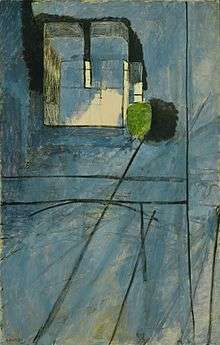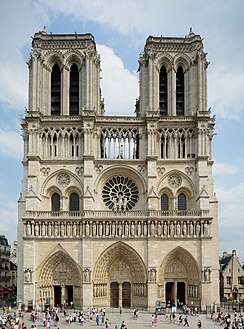View of Notre-Dame
View of Notre-Dame (French: Une vue de Notre-Dame) is an oil painting by Henri Matisse from 1914.

View of Notre-Dame (1914). Oil on canvas, 58 x 37 1/8" (147.3 x 94.3 cm). In the collection of the Museum of Modern Art. Acquired through the Lillie P. Bliss Bequest
Experimental period
Along with works such as Woman on a High Stool, it belongs to the "experimental period" of Matisse's oeuvre. Pentimenti reveal that it was originally painted in a more detailed manner before it was radically simplified into a geometric composition.[1]
Exhibition
It was not exhibited until after Matisse's death, but proved a great influence upon later developments in painting.[1]. Specifically, it is said to have considerably influenced American artists who developed new modern and abstract styles, i.e. Color field and Abstract Expressionism, such as Richard Diebenkorn.
Notes
- Elderfield, John (1996). Henri Matisse: Masterworks from the Museum of Modern Art. New York City: MOMA. ISBN 0-87070-112-6.
gollark: Because they would probably damage things and thus be bad.
gollark: > I'm a very quiet polite person. I have agoraphobia, I never leave or bother anyone> Tbh I'm about to just beat him sensless.
gollark: Well, it might be rude, but it would be ruder and also probably a crime to break their camera.
gollark: Damaging people's things would be a crime. Also trespassing.
gollark: Trying to get revenge on them for... having a camera pointed at you... by breaking the camera probably would not work out very well for you.
References
- Elderfield, 76
This article is issued from Wikipedia. The text is licensed under Creative Commons - Attribution - Sharealike. Additional terms may apply for the media files.
